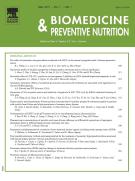Hesperidin safeguards hepatocytes from valproate-induced liver dysfunction in Sprague-Dawley rats - 30/05/14

Abstract |
Hesperidin (HDN), a polyphenolic flavonoid, had drawn attention due to its free radical scavenging and antioxidant activity. Valproate (VPA) is one of the routinely used antiepileptic drugs that has also been associated with hepatotoxicity and its metabolites, like 4-ene VPA and 2,4-diene. VPA are the main contributory compounds in inducing hepatic damage. As lifelong intake of valproate has been recommended, ameliorating its toxicity by administration of safe antioxidants might be beneficial in protecting the liver. The current experiment was designed to test the efficacy of hesperidin on counteracting valproate-induced hepatotoxicity. Male Sprague-Dawley rats were randomly assigned into four groups: Control, VPA, HDN+VPA and HDN. VPA (300mg/kg bwt/day) and HDN (100mg/kg bwt/day) were administered orally for 60 days. At the end of the experimental period, rats were sacrificed and liver was excised for biochemical, mRNA and protein analysis. The extent of hepatotoxicity was assessed by liver marker enzymes, oxidative stressors, antioxidant enzymes, mRNA and protein expression of apoptotic proteins. The efficacy of hesperidin was assessed by the ability to safeguard the liver and prevent apoptosis of the hepatocytes in valproate-treated rats. The activities of liver marker enzymes, macromolecular damage and gene expression of pro- and anti-apoptotic proteins were altered in valproate-treated rats when compared to control rats whereas hesperidin co-treated rats showed significant protection. Hesperidin protects the liver from valproate-induced toxicity by curtailing lipid peroxidation and preventing the cells from entering into apoptosis.
Le texte complet de cet article est disponible en PDF.Keywords : Hesperidin, Valproate, Hepatotoxicity, Apoptosis
Plan
Vol 4 - N° 2
P. 209-217 - avril 2014 Retour au numéroBienvenue sur EM-consulte, la référence des professionnels de santé.
L’accès au texte intégral de cet article nécessite un abonnement.
Déjà abonné à cette revue ?

